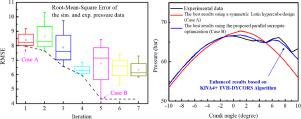Computers & Chemical Engineering ( IF 3.9 ) Pub Date : 2020-11-24 , DOI: 10.1016/j.compchemeng.2020.107180 Liping Wei , Peng Jiang , Wenming Yang , Xiao Liu , Yanjun Dai , Christine A. Shoemaker , Chi-Hwa Wang

|
Successful simulation of the 3D biodiesel engine relies on the accurate input-parameter tuning of the 3D platform named KIVA4-CHEMKIN, which was time- and resource-consuming through traditional uncertainty analyses or experimental design methods. In this study, the input-parameter tuning was treated as an optimization procedure to minimize the root-mean-square error between the simulated in-cylinder pressure and the experimental in-cylinder pressure. A parallel time-varying hyperparameter surrogate algorithm with a radial basis function was proposed to achieve the goal of a favorable solution and less computation time. The key input parameters—the start of injection, injection duration, Sauter mean radius, fuel temperature, and in-cylinder temperature at the intake valve closure—were tuned within their feasible ranges. A 3D KIVA4-CHEMKIN model, involving a skeletal mechanism of 112 species and 498 reactions, was used to test the effectiveness of the 3D biodiesel engine simulation. Only seven iterations with a total of 84 cases could achieve a favorable solution under a parallel paradigm. The possible limitation of the proposed algorithm lies in the mandatory requirement of parallel computing resources. The parameter tuning had an appreciable impact on the estimation of the in-cylinder pressure. The resultant observation—a delayed start of injection with a short injection duration—help to produce a better fitting between the simulated pressure curve and the experimental results.
中文翻译:

使用并行替代优化算法的3D生物柴油发动机输入参数调整
3D生物柴油引擎的成功仿真依赖于名为KIVA4-CHEMKIN的3D平台的精确输入参数调整,这通过传统的不确定性分析或实验设计方法既费时又耗资源。在本研究中,将输入参数调整作为一种优化过程,以最大程度地减小模拟缸内压力与实验缸内压力之间的均方根误差。提出了一种具有径向基函数的并行时变超参数替代算法,以达到解决问题的目的,并减少了计算时间。关键的输入参数-喷射开始,喷射持续时间,Sauter平均半径,燃油温度和进气门关闭时的缸内温度-已在其可行范围内进行了调整。3D KIVA4-CHEMKIN模型,涉及112种物种和498个反应的骨架机制,用于测试3D生物柴油发动机仿真的有效性。在并行范式下,只有七个迭代(总共84个案例)可以实现理想的解决方案。该算法的可能局限在于对并行计算资源的强制性要求。参数调整对缸内压力的估计有明显的影响。所得的观察结果-注射开始时间短,注射持续时间短-有助于在模拟压力曲线和实验结果之间产生更好的拟合。在并行范式下,只有七个迭代(总共84个案例)可以实现理想的解决方案。该算法的可能局限在于对并行计算资源的强制性要求。参数调整对缸内压力的估计有明显的影响。观察到的结果-注射开始时间短,注射持续时间短-有助于在模拟压力曲线和实验结果之间产生更好的拟合。在并行范式下,只有七个迭代(总共84个案例)可以实现理想的解决方案。该算法的可能局限在于对并行计算资源的强制性要求。参数调整对缸内压力的估计有明显的影响。观察到的结果-注射开始时间短,注射持续时间短-有助于在模拟压力曲线和实验结果之间产生更好的拟合。











































 京公网安备 11010802027423号
京公网安备 11010802027423号